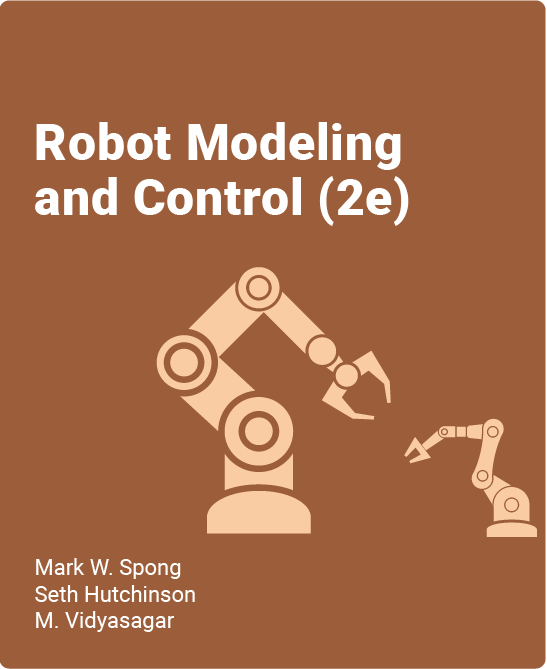Table of Contents
1. Introduction
1.1 Mathematical Modeling of Robots
1.1.1 Symbolic Representation of Robot Manipulators
1.1.2 The Configuration Space
1.1.3 The State Space
1.1.4 The Workspace
1.2 Robots as Mechanical Devices
1.2.1 Classification of Robotic Manipulators
1.2.2 Robotic Systems
1.2.3 Accuracy and Repeatability
1.2.4 Wrists and End Effectors
1.3 Common Kinematic Arrangements
1.3.1 Articulated Manipulator (RRR)
1.3.2 Spherical Manipulator (RRP)
1.3.3 SCARA Manipulator (RRP)
1.3.4 Cylindrical Manipulator (RPP)
1.3.5 Cartesian Manipulator (PPP)
1.3.6 Parallel Manipulator 18
1.4 Outline of the Text
1.4.1 Manipulator Arms
1.4.2 Underactuated and Mobile Robots
Problems
Notes and References
I The Geometry of Robots
2. Rigid Motions
2 Rigid Motions
2.1 Representing Positions
2.2 Representing Rotations
2.2.1 Rotation in the Plane
2.2.2 Rotations in Three Dimensions
2.3 Rotational Transformations
2.4 Composition of Rotations
2.4.1 Rotation with Respect to the Current Frame
2.4.2 Rotation with Respect to the Fixed Frame
2.4.3 Rules for Composition of Rotations
2.5 Parameterizations of Rotations
2.5.1 Euler Angles
2.5.2 Roll, Pitch, Yaw Angles
2.5.3 Axis-Angle Representation
2.5.4 Exponential Coordinates
2.6 Rigid Motions
2.6.1 Homogeneous Transformations
2.6.2 Exponential Coordinates for General Rigid Motions
2.7 Chapter Summary
Problems
Notes and References
3. Forward Kinematics
3.1 Kinematic Chains
3.2 The Denavit-Hartenberg Convention
3.2.1 Existence and Uniqueness
3.2.2 Assigning the Coordinate Frames
3.3 Examples
3.3.1 Planar Elbow Manipulator
3.3.2 Three-Link Cylindrical Robot
3.3.3 The Spherical Wrist
3.3.4 Cylindrical Manipulator with Spherical Wrist
3.3.5 Stanford Manipulator
3.3.6 SCARA Manipulator
3.4 Chapter Summary
Problems
Notes and References
4. Velocity Kinematics
4.1 Angular Velocity: The Fixed Axis Case
4.2 Skew-Symmetric Matrices
4.2.1 Properties of Skew-Symmetric Matrices
4.2.2 The Derivative of a Rotation Matrix
4.3 Angular Velocity: The General Case
4.4 Addition of Angular Velocities
4.5 Linear Velocity of a Point Attached to a Moving Frame
4.6 Derivation of the Jacobian
4.6.1 Angular Velocity
4.6.2 Linear Velocity
4.6.3 Combining the Linear and Angular Velocity Jacobians
4.7 The Tool Velocity
4.8 The Analytical Jacobian
4.9 Singularities
4.9.1 Decoupling of Singularities
4.9.2 Wrist Singularities
4.9.3 Arm Singularities
4.10 Static Force/Torque Relationships
4.11 Inverse Velocity and Acceleration
4.12 Manipulability
4.13 Chapter Summary
Problems
Notes and References
5. Inverse Kinematics
5.1 The General Inverse Kinematics Problem
5.2 Kinematic Decoupling
5.3 Inverse Position: A Geometric Approach
5.3.1 Spherical Configuration
5.3.2 Articulated Configuration
5.4 Inverse Orientation
5.5 Numerical Inverse Kinematics
5.6 Chapter Summary
Problems
Notes and References
II Dynamics and Motion Planning
6.Dynamics
6.1 The Euler-Lagrange Equations
6.1.1 Motivation
6.1.2 Holonomic Constraints and Virtual Work
6.1.3 D’Alembert’s Principle
6.2 Kinetic and Potential Energy
6.2.1 The Inertia Tensor
6.2.2 Kinetic Energy for an n-Link Robot
6.2.3 Potential Energy for an n-Link Robot
6.3 Equations of Motion
6.4 Some Common Configurations
6.5 Properties of Robot Dynamic Equations
6.5.1 Skew Symmetry and Passivity
6.5.2 Bounds on the Inertia Matrix
6.5.3 Linearity in the Parameters
6.6 Newton-Euler Formulation
6.6.1 Planar Elbow Manipulator Revisited
6.7 Chapter Summary
Problems
Notes and References
7. Path and Trajectory Planning
7.1 The Configuration Space
7.1.1 Representing the Configuration Space
7.1.2 Configuration Space Obstacles
7.1.3 Paths in the Configuration Space
7.2 Path Planning for Q = ℝ2
7.2.1 The Visibility Graph
7.2.2 The Generalized Voronoi Diagram
7.2.3 Trapezoidal Decompositions
7.3 Artificial Potential Fields
7.3.1 Artificial Potential Fields for Q = ℝn
7.3.2 Potential Fields for Q ≠ ℝn
7.4 Sampling-Based Methods
7.4.1 Probabilistic Roadmaps (PRM)
7.4.2 Rapidly-Exploring Random Trees (RRTs)
7.5 Trajectory Planning
7.5.1 Trajectories for Point-to-Point Motion
7.5.2 Trajectories for Paths Specified by Via Points
7.6 Chapter Summary
Problems
Notes and References
8. Independent Joint Control
8.1 Introduction
8.2 Actuator Dynamics
8.3 Load Dynamics
8.4 Independent Joint Model
8.5 PID Control
8.6 Feedforward Control
8.6.1 Trajectory Tracking
8.6.2 The Method of Computed Torque
8.7 Drive-Train Dynamics
8.8 State Space Design
8.8.1 State Feedback Control
8.8.2 Observers
8.9 Chapter Summary
Problems
Notes and References
9. Nonlinear and Multivariable Control
9.1 Introduction
9.2 PD Control Revisited
9.3 Inverse Dynamics
9.3.1 Joint Space Inverse Dynamics
9.3.2 Task Space Inverse Dynamics
9.3.3 Robust Inverse Dynamics
9.3.4 Adaptive Inverse Dynamics
9.4 Passivity-Based Control
9.4.1 Passivity-Based Robust Control
9.4.2 Passivity-Based Adaptive Control
9.5 Torque Optimization
9.6 Chapter Summary
Problems
Notes and References
10.Force Control
10.1 Coordinate Frames and Constraints
10.1.1 Reciprocal Bases
10.1.2 Natural and Artificial Constraints
10.2 Network Models and Impedance
10.2.1 Impedance Operators
10.2.2 Classification of Impedance Operators
10.2.3 Thévenin and Norton Equivalents
10.3 Task Space Dynamics and Control
10.3.1 Impedance Control
10.3.2 Hybrid Impedance Control
10.4 Chapter Summary
Problems
Notes and References
11. Vision-Based Control
11.1 Design Considerations
11.1.1 Camera Configuration
11.1.2 Image-Based vs. Position-Based Approaches
11.2 Computer Vision for Vision-Based Control
11.2.1 The Geometry of Image Formation
11.2.2 Image Features
11.3 Camera Motion and the Interaction Matrix
11.4 The Interaction Matrix for Point Features
11.4.1 Velocity Relative to a Moving Frame
11.4.2 Constructing the Interaction Matrix
11.4.3 Properties of the Interaction Matrix for Points
11.4.4 The Interaction Matrix for Multiple Points
11.5 Image-Based Control Laws
11.5.1 Computing Camera Motion
11.5.2 Proportional Control Schemes
11.5.3 Performance of Image-Based Control Systems
11.6 End Effector and Camera Motions
11.7 Partitioned Approaches
11.8 Motion Perceptibility
11.9 Summary
Problems
Notes and References
12.Feedback Linearization
12.1 Background
12.1.1 Manifolds, Vector Fields, and Distributions
12.1.2 The Frobenius Theorem
12.2 Feedback Linearization
12.3 Single-Input Systems
12.4 Multi-Input Systems
12.5 Chapter Summary
Problems
Notes and References
13. Underactuated RobotsToggle Title
13.1 Introduction
13.2 Modeling
13.3 Examples of Underactuated Robots
13.3.1 The Cart-Pole System
13.3.2 The Acrobot
13.3.3 The Pendubot
13.3.4 The Reaction-Wheel Pendulum
13.4 Equilibria and Linear Controllability
13.4.1 Linear Controllability
13.5 Partial Feedback Linearization
13.5.1 Collocated Partial Feedback Linearization
13.5.2 Noncollocated Partial Feedback Linearization
13.6 Output Feedback Linearization
13.6.1 Computation of the Zero Dynamics
13.6.2 Virtual Holonomic Constraints
13.7 Passivity-Based Control
13.7.1 The Simple Pendulum
13.7.2 The Reaction-Wheel Pendulum
13.7.3 Swingup and Balance of The Acrobot
13.8 Chapter Summary
Problems
Notes and References
14. Mobile Robots
14.1 Nonholonomic Constraints
14.2 Involutivity and Holonomy
14.3 Examples of Nonholonomic Systems
14.4 Dynamic Extension
14.5 Controllability of Driftless Systems
14.6 Motion Planning
14.6.1 Conversion to Chained Forms
14.6.2 Differential Flatness
14.7 Feedback Control of Driftless Systems
14.7.1 Stabilizability
14.7.2 Nonsmooth Control
14.7.3 Trajectory Tracking
14.7.4 Feedback Linearization
14.8 Chapter Summary
Problems
Notes and References
References
A Trigonometry
A.1 The Two-Argument Arctangent Function
A.2 Useful Trigonometric Formulas
B Linear Algebra
B.1 Vectors
B.2 Inner Product Spaces
B.3 Matrices
B.4 Eigenvalues and Eigenvectors
B.5 Differentiation of Vectors
B.6 The Matrix Exponential
B.7 Lie Groups and Lie Algebras
B.8 Matrix Pseudoinverse
B.9 Schur Complement
B.10 Singular Value Decomposition (SVD)
C Lyapunov Stability
C.1 Continuity and Differentiability
C.2 Vector Fields and Equilibria
C.3 Lyapunov Functions
C.4 Stability Criteria
C.5 Global and Exponential Stability
C.6 Stability of Linear Systems
C.7 LaSalle’s Theorem
C.8 Barbalat’s Lemma
D Optimization
D.1 Unconstrained Optimization
D.2 Constrained Optimization
E Camera Calibration
E.1 The Image Plane and the Sensor Array
E.2 Extrinsic Camera Parameters
E.3 Intrinsic Camera Parameters
E.4 Determining the Camera Parameters
Bibliography
Index
zyText are leading print textbooks available in full on the zyBooks platform. Each zyText has been adapted to include learning questions and answer-specific feedback allowing for a quick and easy transition to an engaging digital experience for instructors and students.
What You’ll Find in this zyText:
-
- Incorporates the complete text
- Over 150 learning questions with answer-specific feedback
- Customization tools letting you add, remove or reorder chapters and sections
- Options to align the book directly to your syllabus – including videos, images, text
- Analytics that help you measure student engagement
- Ability to hold students accountable for reading before class
- A competitive low price point
- Students can keep a PDF version of key chapters at no additional cost
Covering the theoretical fundamentals and latest technological advances in robot kinematics. With so much advancement in technology, from robotics to motion planning, society can implement more powerful and dynamic algorithms than ever before. This in-depth guide educates readers in the fundamentals of robotic and motion control with in-depth control theory and nonlinear system analysis.
New case studies covering topics such as:
- Motion-planning, collision avoidance, trajectory optimization, and control of robots
- Popular topics within the robotics industry and how they apply to various technologies
- An expanded set of examples, simulations, problems, and case studies
- Open-ended suggestions for students to apply the knowledge to real-life situations
Authors
Mark W. Spong,
Seth Hutchinson
M. Vidyasagar

